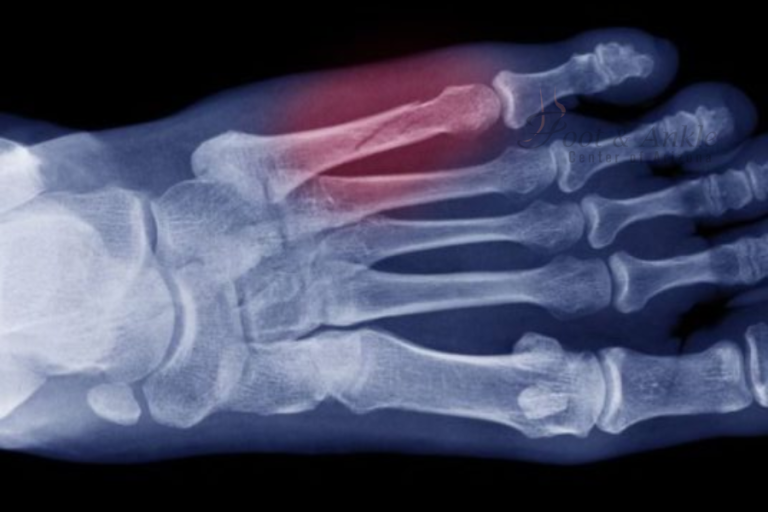Foot and Ankle Center of Arizona is the most professional and premier resource for you in Scottsdale, AZ, for Ankle Fracture Heal. We believe in making the process hassle-free by keeping our patients informed and comfortable throughout, so we will be more than happy to help you at any point in time.
Overview of Ankle Fracture Heal
A Broken Ankle?
Ankle fracture is a condition whereby one or more bones that compose the ankle joint are broken. This can be a break in the tibia, fibula, or talus bone. The tibia is usually known as the shinbone, while the fibula refers to the outer leg bone. The talus is a small bone between the heel bone and the tibia and fibula.
Causes of Ankle Fracture
Ankle fractures have various causes, including:
- Falls
- Twisting injuries
- Sports accidents
- Car accidents
- Direct trauma to the ankle
Symptoms of Ankle Fracture
Some of the common symptoms of an ankle fracture include:
- Severe pain and tenderness
- Swelling and bruising
- Inability to bear weight
- Deformity of the ankle
- Difficulty moving the ankle
How Can I Tell If My Ankle Is Broken?
If a break in the ankle is suspected, it is essential to see a doctor. It becomes evident that there might be a fracture if one has severe pain, swelling, and an inability to walk or bear weight on the foot with a problem. An X-ray is usually needed to confirm the diagnosis.
Can I Walk on a Broken Ankle?
Generally, walking on a broken ankle is not advisable since it can aggravate the injury and hinder healing. It will help if the ankle is adequately immobilized and urgent medical advice is sought.
How Do Ankle Fractures Happen?
Most ankle fractures are due to high-impact injuries from falls, sports accidents, or car crashes. They can also be the result of an extremely twisted ankle, which causes one or more of the bones that make up the ankle to break.
Can an Ankle Sprain Cause a Broken Ankle?
While an ankle sprain and an ankle fracture are different types of injuries to the ankle, a person can have a severe sprain and a fracture at the same time. Pain and swelling are present in both, but generally, a fracture is more painful.
Diagnosis and Tests
How Are Ankle Fractures Diagnosed by Healthcare Providers?
A healthcare professional can diagnose an ankle fracture by physical examination and through imaging tests. However, though X-rays are the most common way to diagnose, more complex fractures require CT scans or MRIs.
Are There Different Kinds of Ankle Fractures?
Yes, there are kinds of ankle fractures. The kinds of ankle fracture are:
- Lateral malleolus fracture (involving the fibula)
- Medial malleolus fracture (involving the tibia)
- Posterior malleolus fracture (involving the back part of the tibia)
- Bimalleolar fracture (involving both the tibia and fibula)
- Trimalleolar fracture (involving the tibia, fibula, and talus)
What is the Difference Between a Stress Fracture and a Bone Fracture?
A stress fracture is a small crack in the bone, usually caused by overuse or repetitive force. On the other hand, a bone fracture is a complete or incomplete break in the bone, which results from high-impact injury to the bone.
Treatment and Management
How are Ankle Fractures Treated?
Treatment for ankle fractures depends on the severity and type of fracture. Options include:
- Immobilization with a cast or splint
- Pain management
- Physical therapy
- Surgery (in severe cases)
What Surgery is Done for Ankle Fracture?
An open reduction and internal fixation is the most common, serious, surgical procedure for an ankle fracture. This surgery Readjusts the bone segments into their original position then holds them in place internally using screws, plates, rods, or pins.
What Before ORIF Surgery?
Before ORIF surgery is performed, there are usually some preoperative evaluations like blood tests and imaging. An anesthesia consultant will discuss options for anesthesia, together with instructions on fasting and medication adjustments.
What Happens During an ORIF Surgery for an Ankle Fracture?
In ORIF surgery, the surgeon makes an incision over the fractured area and repositions the bone fragments. The fragments are then secured with metal hardware. After closure of the incision, a cast or splint is put on to immobilize the ankle.
What Are the Complications With Ankle Fracture Surgery?
Complications from ankle fracture surgery can include:
- Infection
- Nerve damage
- Blood clots
- Delayed healing
- Hardware irritation
How Long Does It Take to Recover From Ankle Fracture Surgery?
Recovery from ankle fracture surgery varies, but it usually takes several weeks to months. Patients often have to undergo physical therapy to regain strength and mobility. It may take a year or more to achieve a full recovery.
Prevention
How Can I Prevent Ankle Fractures?
The following tips may help you in the prevention of ankle fractures:
- Wear appropriate footwear
- Strengthen ankle muscles through exercise
- Practice proper techniques in sports
- Avoid high-risk activities
- Use caution on uneven surfaces
Outlook / Prognosis
How Long Does it Take to Heal From a Broken Ankle?
Healing time for a broken ankle varies, but on average, it will take six to twelve weeks. If the nature of the fracture is serious or surgery is involved, then the healing process may be longer.
When Will I Be Able to Return to Work or School?
Return to work or school is permissible when the fracture has healed enough and by individual discretion of the work or activities. Most patients can return to normal activities in a few months, although this must be decided on an individual basis.
What Follow-Up Appointments Will I Need After My Surgery?
Follow-up appointments are very important to check on healing. These are usually:
- An initial post-operative visit within a week
- Follow-up visits every few weeks for X-rays and checkups
- Physical therapy sessions
When Should I Call My Doctor or Go to the Emergency Room?
Call your doctor or go to the emergency room if you have:
- Increased pain or swelling
- Signs of infection (redness, warmth, pus)
- Numbness or tingling
- Difficulty moving the ankle
- Fever
What Questions Should I Ask My Doctor?
You may want to ask your doctor:
- What type of fracture do I have?
- What treatment options are available?
- What is the expected recovery time?
- Are there any activity restrictions?
- What are the potential risks and complications of treatment?
When to Seek Medical Care
Ankle Fracture Treatment Self-Care at Home
Home care for an ankle fracture includes:
- Keeping the ankle as immobile and as elevated as possible
- Applying ice to reduce swelling
- Taking prescribed pain medications
- Following your doctor’s instructions on how much weight you can put on the ankle
Medical Treatment
Treatment in the medical aspects that may be entailed include immobilization by use of a cast or splinting, pain management, physical therapy, and, if indicated, surgical intervention.
- Next Steps Follow-Up
- Healing at Your Own Pace
Everybody heals a bit differently. Be patient and don’t rush your recovery. Take good care of your ankle and let it heal at its own rate. This will help you avoid complications.
Give Your Fractured Ankle a Break
Rest is an essential factor in the healing process. Keep unnecessary stress off of your ankle and adhere to weight-bearing instructions set by your healthcare provider.
Follow-Up With Your Provider
Follow-up appointments will help your doctor track your progress and healing. Don’t skip any of these visits and discuss any concerns with your doctor—don’t walk on a fractured ankle too early until your doctor allows it. It may further delay the healing process and cause additional complications.
Am I Able to Walk with a Fractured Ankle?
It is not advisable to walk on a fractured ankle until you get permission from your doctor. It can delay the healing process, and you may have some complications.
How Long Do I Need to Keep Off a Fractured Ankle?
The time frame of non-weight bearing is determined by the severity of the fracture and the mode of its treatment. This basically extends to weeks or even months
Recovery Time for Ankle Fracture
Recovery time varies for people, but most often it ranges between six to twelve weeks for most of the fractures. Severe fractures and those that need surgical intervention take a bit longer period.
Lateral Malleolus Fracture
A lateral malleolus fracture is a break in the fibula bone on the outside of the ankle. It is the most common type of ankle fracture.
Posterior Malleolus Fracture
A posterior malleolus fracture is a fracture of the back portion of the tibia. It is not as common and frequently occurs with other injuries to the ankle.
Bimalleolar Fracture and Bimalleolar Equivalent Fracture
A bimalleolar fracture affects the tibia and fibula, while a bimalleolar equivalent fracture is a break in at least one bone and a ligament injury in the other bone. These fractures almost invariably require surgical intervention.
Trimalleolar Fracture
A trimalleolar fracture refers to breaks in the tibia, fibula, and talus. Quite often, this type of severe injury may require surgical intervention and will be associated with a longer recovery time.
Frequently Asked Questions (FAQs)
What is the difference between a stress fracture and a bone fracture?
A stress fracture is usually a small-sized crack in the bone caused by overuse or repetitive force. On the other hand, a bone fracture is a complete or partial break in the bone, normally caused by high-impact injury. How will I know if my ankle is broken?
You may have a broken ankle in the presence of severe pain, swelling, bruising, inability to bear weight, and deformity of the ankle. An X-ray is, however, often required to confirm this diagnosis.
Am I able to walk on a broken ankle?
It is not usually advisable to walk on a broken ankle. This is because walking can aggravate the injury and delay its healing. Immobilize the ankle and seek urgent medical advice.
How long does it take to recover from ankle fracture surgery?
Recovery from ankle fracture surgery could take weeks to months. Depending on the extent of the injury, and on general health, it may take up to a year before one fully recuperates, which includes regaining their strength and mobility.
What is done during an ORIF procedure for an ankle fracture?
ORIF stands for Open Reduction and Internal Fixation. During the procedure, the surgical incision overlying the fractured area is done first; then, the surgeon places the bone fragments back into their proper position and holds them together with appropriate metal hardware. The incision is closed, and finally, a cast or splint is applied to the ankle to immobilize it.
What are the complications of ankle fracture surgery?
Some of the complications related to ankle fracture surgery are infection, nerve damage, blood clots, delayed healing, and hardware irritation. Follow carefully the postoperative care advice that your surgeon will give you to minimize potential risks.
How long does it take for a broken ankle to heal?
Generally, it will take six to twelve weeks for a broken ankle to get healed. Severe fractures or those that require surgical procedures need a very long time to be completely healed.
What are some ways to prevent ankle fractures?
Wearing proper shoes will also help to prevent broken ankles. Exercise can be done to strengthen the muscles in the ankles. Proper techniques in sports will help avoid contact that may result in a broken ankle. Avoid high-risk activities and use caution on uneven surfaces.
How would you know if your ankle is fractured?
If you think that you may have a fractured ankle, you need to see a doctor right away. Immobilize the ankle. Do not bear weight. Apply ice to reduce swelling. An X-ray will allow confirmation of the diagnosis and appropriate treatment.
How soon can I return to work/school after an ankle fracture?
Return to work or school depends on the severity of the fracture and the nature of the work or activities. While most patients do routine activities a few months after surgery, this again varies from person to person. Follow your provider’s advice to return safely.
Conclusion
At the Foot and Ankle Center of Arizona, we realize that an ankle fracture may be frustrating and worrisome. For this very reason, our proficient team in Scottsdale, AZ, attaches great value to effective and high-quality treatment for quick and full recovery.
Be it the initial diagnosis or intense treatment, including the post-surgery rehabilitation process, we will guide you through all stages of recovery. We practice state-of-the-art technology aided by advanced medical techniques in treating various types of ankle fractures—in particular, lateral malleolus, posterior malleolus, bimalleolar, and trimalleolar fractures.
Our approach to this is individualizing care so that each patient receives appropriate treatment on the best possible route for his/her injury. From conservative treatment to surgical interventions like ORIF, we have experts who can help one transition through the path to health and resume regular activities as soon as possible.
This is of equal importance to treatment, and we advise you on how to minimize your risk of injury. If you do fracture an ankle, be assured that our team will quickly and efficiently treat you through each and every step, from evaluation to the final stages of rehabilitation.
If you have any further questions or need assistance, please do not hesitate to contact us. Your health and well-being are very important to us, and our team is committed to doing all it can to facilitate your healing process so you can get back on your feet in the best possible way. Thank you for choosing the Foot and Ankle Center of Arizona for your ankle fracture healing needs.





